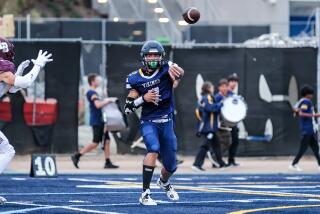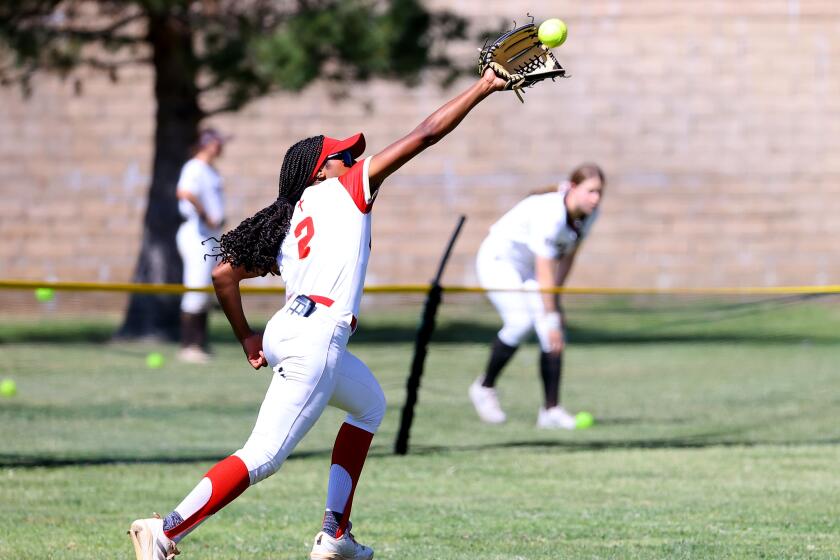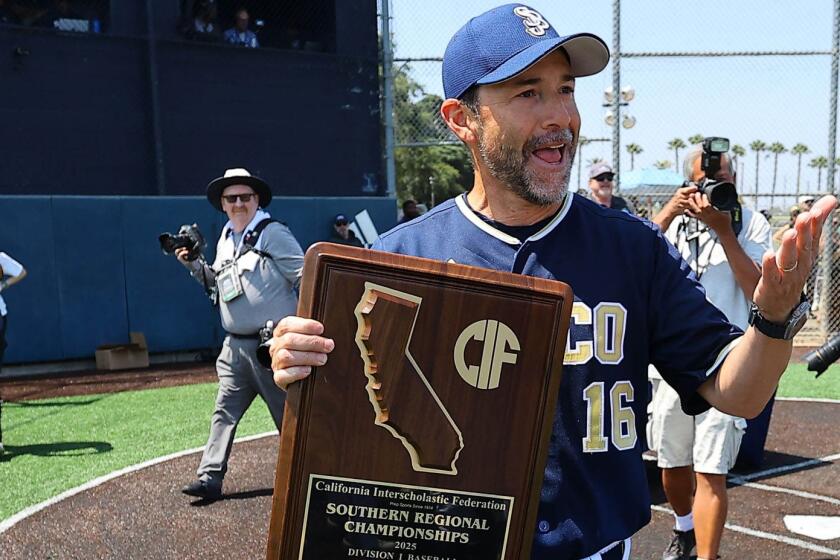USD Winning Without List of Big Names : College basketball: Toreros are atop West Coast Conference even though top recruits go elsewhere.
- Share via
SAN DIEGO — When talk turns to national high school and junior college basketball recruits, the University of San Diego rarely, if ever, enters the conversation.
Plain and simple, the University of San Diego rarely, if ever, signs a top-notch recruit.
Have there been any in the past five years? In the past 10? Ever?
Probably not.
Hank Egan himself, USD’s coach the past seven seasons, was hard pressed to think of any high school blue-chippers outside of Scott Thompson and Gylan Dottin to choose USD. And even those were pale blue at best.
Yet, Egan and his unballyhooed Toreros are alone in first midway through the 1991 West Coast Conference season.
This has happened because of what players have done after they arrived at Alcala Park, not before. USD’s portfolio was not built with blue-chip stocks, but it is growing nonetheless.
From Dondi Bell to Kelvin Woods and everyone in between, Egan and his staff have had to develop in some way every Torero. No one came to USD with a can’t-miss tag attached. Egan has had to refine skills--in some cases, find skills--in order to build a winner.
Egan deflects most of the credit to his assistants and hard work on the part of the players, but surely he has played a major role.
And his peers have taken notice. Twice Egan has been selected the WCC coach of the year--the only two-time winner among the eight active coaches--and he might just earn a third award after this season. Certainly, he is deserving, if only for putting this bunch together.
It wasn’t easy.
Take Bell.
When Egan signed Bell five years ago out of Crawford High, few bells were rung. Newspapers did not alter the layout of their sports pages. Hardly anyone knew or cared, in fact.
A guy who runs one of the biggest local scouting services, who is paid by universities to identify the best talent in San Diego, called Egan after reading about the signing and asked, “Who is this Dondi Bell?”
“He didn’t have the slightest idea who he was,” said Egan, but then, just a few weeks earlier, he didn’t have the slightest idea who Bell was either.
Mike Legarza, then the recruiting coordinator for USD, had convinced Egan to take a look at Bell, a 6-foot-9 center with raw athletic skills and little basketball experience.
“The first time I saw (Bell),” Egan said, “I saw him go way up to grab this offensive rebound. And I wondered as he’s grabbing this offensive rebound with these tremendously long arms why everyone had missed on him.
“Then he went back up to shoot the ball . . . and I understood.”
After redshirting his first year and playing sparingly the next, Bell has been one of the best rebounders and shot blockers in the WCC the past three years . . . and he is averaging 9.2 points per game this season. Even his free-throw shooting, which hovered around 50% his first three years, is up to 62% this year.
Asked what Egan taught him, Bell said: “You can never be satisfied. If you are, then it’s time to give up the game. People who are satisfied don’t climb that much.”
Take Wayman Strickland.
He averaged 22 points and eight rebounds per game and was the San Francisco city player of the year three years ago at Riordan High.
The problem was, Strickland was barely 6-1 and playing forward. He’s listed at 6-2 now and has been the point guard for most of his three years at USD.
Last year, Strickland missed the USD single-season assist record by two. Last week at Portland and Gonzaga, he scored 27 and 23 points, making 70% of his shots, including eight of 12 three-pointers.
Strickland pointed out before the trip that his two biggest areas of development have been adapting to the intricacies of the point and learning to take good shots. His numbers indicate he has learned well.
Egan: “(Strickland) I think has made the biggest improvement in the course of his time here, and maybe one of the . . . biggest improvement in my 20 years of coaching.”
That is not to say the change came easily or overnight. Strickland has struggled, and he has probably taken more criticism from Egan than any player on the team.
“He expects a lot from me, and I expect a lot from myself,” Strickland said. “I’d be worried if I messed up, and he stopped yelling at me and didn’t care.”
There are other examples.
Junior forward Kelvin Woods has developed into a strong inside/outside scoring threat and rebounder despite being only 6-5.
Senior center Keith Colvin, who averaged only 1.3 points and 1.9 rebounds in nine games last year, is up to 3.7 points and 3.2 rebounds this year and has contributed in every game in relief of Bell.
Sophomore Geoff Probst, who redshirted last year after coming to USD as a walk-on transfer from UC Davis, is by his own assessment short and slow, but he has played a major role off the bench at point guard. He has given Strickland some needed rest as well as time at off-guard.
Probst had missed five games with a broken finger, but USD (13-6) is 11-3 and riding a six-game winning streak with him available.
“Here’s a guy who had to talk his way in here, and we find out he has all the skills and tools,” Egan said. “This is one that is not necessarily developing here. We and a lot of other schools just missed him.”
Redshirts Dottin and Lincoln High’s Joe Temple, like Strickland, played out of position in high school.
Dottin was the freshman of the year in the WCC two years ago and the Toreros’ third-leading scorer last year before breaking his nose midway through the season. Temple played in nine games last year.
Both are developing into big-time guards, according to Egan.
“Maybe the best example (of player development),” Egan said, “is Joe Temple, who I think has got the potential to be one of the best players we’ve had around here.
“And I always say potential, because in the growth process, the individual’s commitment to learn and change are two very different things. Learning’s easy, but changing’s hard.
“You’ve got to give up some of the good that you do in order to change. You’re going to go down a little bit in what you look like and what you seem like. And you’re going to make some errors. Changing and going through that changing process, you have to be willing to look bad some times. And that’s hard for young people.
“Joe has started to overcome his fear of looking bad. And so now he’s going through some growth process. He’s got a great opportunity.”
And then there are the five transfers from Mesa (Ariz.) Community College--Anthony Thomas, Pat Holbert, Reed Watson, Michael Brown and Shawn Hamilton.
Each began his development at Mesa under Tom Bennett, a friend of Egan’s. He is also the father of former UC San Diego guard Randy Bennett, who recruits for Egan and works with USD’s guards.
Thomas is the Toreros’ leading scorer (15.3) and rebounder (5.4). Holbert was the leading scorer before falling into a mild slump, but he is still averaging 12.3 points. Both are two-year players who have developed in their respective roles.
Watson and Brown, both juniors, are sixth and seventh on the team in scoring and will be counted on even more next year when USD loses six seniors, including Hamilton, who underwent a hernia operation earlier this month.
“There are three things you’re sure of when we get a kid from (Mesa),” Egan said. “One, they’re fundamentally sound. Two, they’re good people. If Tom Bennett recommends them, they are not going to be problem kids. And the third thing is that (Tom Bennett) is an English professor. He stresses the school part of it. His kids take the kind of core classes that will transfer here. He makes sure his prospects have that kind of background.”
And therein lies the distinction with every USD recruit.
They may not have all the basketball experience or savvy Egan would prefer, but they all have some kind of positive background. Whether it’s in athletics or academics, there is something there.
“A lot of their growth is due to opportunity,” Egan said. “If they went some place else, they’d probably sit. Here, they get to play.
“Opportunity is a great teacher.”
More to Read
Get our high school sports newsletter
Prep Rally is devoted to the SoCal high school sports experience, bringing you scores, stories and a behind-the-scenes look at what makes prep sports so popular.
You may occasionally receive promotional content from the Los Angeles Times.






